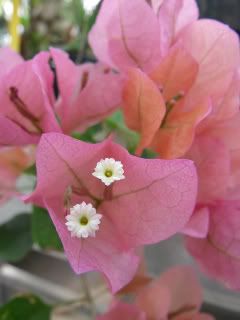Bougainvillea

Bougainvillea is a woody tropical vine native to Brazil. It is popular as a garden plant in regions of the world where it never gets to freezing temperatures, but that leaves a whole lot of people who aren't able to enjoy it out-of-doors. Fortunately for us, Bougainvillea is remarkably adaptable as a hanging basket, potted plant, or even as a bonsai specimen.
 Bright light should be provided for your Bougainvillea year-round. The more sun, the better. Placing the plant near a window that receives light all day is ideal. Eastern or western facing windows are also good choices. If none of those are available to you, fluorescent lighting may be necessary if you must grow a bougainvillea. Summering the plant outside in the warm weather is a great way to give it an annual boost, but you must be sure to acclimate it to the full strength of the sun.
Bright light should be provided for your Bougainvillea year-round. The more sun, the better. Placing the plant near a window that receives light all day is ideal. Eastern or western facing windows are also good choices. If none of those are available to you, fluorescent lighting may be necessary if you must grow a bougainvillea. Summering the plant outside in the warm weather is a great way to give it an annual boost, but you must be sure to acclimate it to the full strength of the sun.
Keep your Bougainvillea on the dry side and in a pot that is just big enough, never too big. They are heavy feeders and will appreciate being fertilized at every other watering with a water-soluble fertilizer. In periods of more active growth you may want to fertilize even more often than that. A slow release fertilizer is another good choice, if you don't like having to mix fertilizer solution on a regular basis.
Bougainvilleas have delicate root systems and like to be pot-bound so re-potting should be done as infrequently as possible. When transferring the plant, take extra care with the root-ball; try not to traumatize it too much. I like clay pots, personally, as they offer the best air exchange and help the potting mix dry out most quickly.
Plants can be easily propagated from cuttings. Cuttings should be about 5 inches long and will root in one to two months. While cuttings are rooting, keep them out of direct sun, provide them with mild temperatures and keep humidity up.
Potential pests you may find on your Bougainvillea depend on where its been; if you summer it outdoors you may find a few more types of insects than if you keep indoors year-round. Mealybugs and spider mites are the most common nuisances but both can be discouraged by the use of a systemic insecticide. If that is not enough, mealybugs may be removed with cotton swabs dipped in rubbing alcohol and spider mites can be wiped from the bottoms of leaves with a soapy washcloth. Horticultural oil is a good choice for managing both when the more basic methods fail.

Keep your Bougainvillea on the dry side and in a pot that is just big enough, never too big. They are heavy feeders and will appreciate being fertilized at every other watering with a water-soluble fertilizer. In periods of more active growth you may want to fertilize even more often than that. A slow release fertilizer is another good choice, if you don't like having to mix fertilizer solution on a regular basis.
Bougainvilleas have delicate root systems and like to be pot-bound so re-potting should be done as infrequently as possible. When transferring the plant, take extra care with the root-ball; try not to traumatize it too much. I like clay pots, personally, as they offer the best air exchange and help the potting mix dry out most quickly.
Plants can be easily propagated from cuttings. Cuttings should be about 5 inches long and will root in one to two months. While cuttings are rooting, keep them out of direct sun, provide them with mild temperatures and keep humidity up.
Potential pests you may find on your Bougainvillea depend on where its been; if you summer it outdoors you may find a few more types of insects than if you keep indoors year-round. Mealybugs and spider mites are the most common nuisances but both can be discouraged by the use of a systemic insecticide. If that is not enough, mealybugs may be removed with cotton swabs dipped in rubbing alcohol and spider mites can be wiped from the bottoms of leaves with a soapy washcloth. Horticultural oil is a good choice for managing both when the more basic methods fail.
This site needs an editor - click to learn more!

Related Articles
Editor's Picks Articles
Top Ten Articles
Previous Features
Site Map
Content copyright © 2023 by Lisa Beth Voldeck. All rights reserved.
This content was written by Lisa Beth Voldeck. If you wish to use this content in any manner, you need written permission. Contact
BellaOnline Administration
for details.


